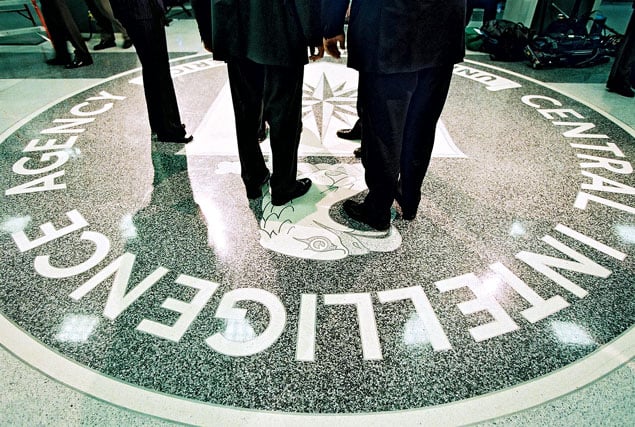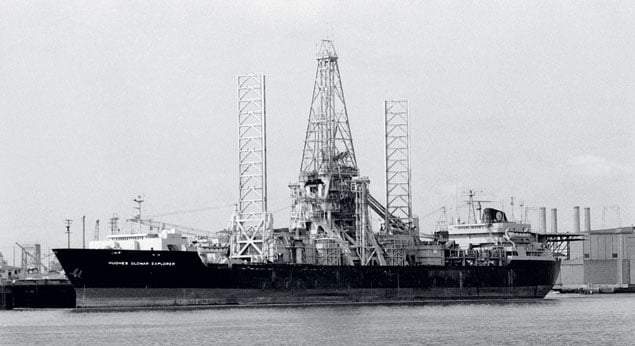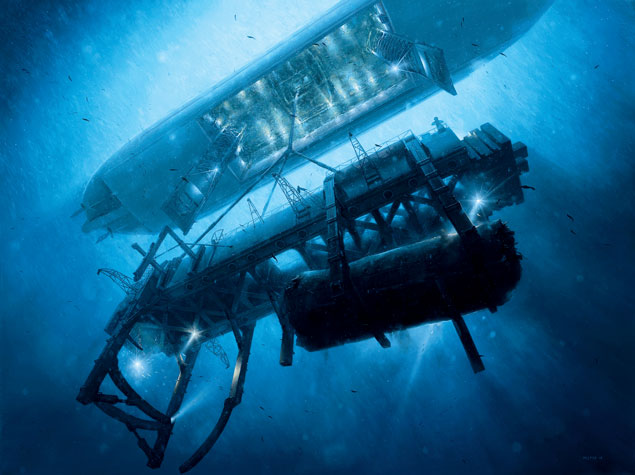“We can neither confirm nor deny that this is our first tweet.”—@CIA, entering the Twitterverse on June 6, 2014
I tiptoe onto the old woman’s lawn, just like every other morning, and switch the two newspapers: her copy of the Washington Post for mine. We have a routine down by now, me and her, and I know within a few seconds there’ll be a signal (or not) telling me whether the mission was a success.
Some agents go for an upside-down flag in a window, others for a chalk mark on a bench—tradecraft, we call it—but I’m dealing with a particularly old-school spook. For a few seconds, nothing. Then in a flash, almost imperceptible to someone not in our line of work, it appears. The curtains sway ever so slightly. She has seen.
Failure. Every day a failure! Let me tell you something—when your six-month-old puppy rips up the newspaper of your elderly neighbor, and I mean rips it to smithereens, and you’re trying to do the right thing by replacing that shredded copy with an intact one of your own, take it from me: Make sure the house isn’t owned by retired spies. ’Cause they don’t miss a thing.
Welcome to my neighborhood. My street is a five-minute drive to the main gate of the CIA. For 16 years, I’ve craned my neck driving by that entrance, each time hoping to see something other than a disappearing road. All of us knew that both Mr. and Mrs. Carlson spent their lives working for the Agency. Around here, it’s more of a question of who isn’t retired CIA. I mean, I’m not—but I do love a good story.
Rod and Pat Carlson had stories by the boatload but never told them. They moved onto the block in 1967 and rarely chitchatted with us newcomers. Rod had a gaunt, Amish look about him—I always expected to see him swinging an ax. Pat was a wisp, so frail that I worried she’d get blown over on windy days. I’d be in line at Safeway and she’d suddenly appear behind me, very ghosty but always very sweet, too.
It’s funny—for years the Carlsons lived a hundred feet from me and I never asked what they did at the Agency. He died in 2004, and for the next eight years she was on her own. I always did my best to shovel her walk after a snowstorm. She’d rarely come out, but the drapes would sway ever so slightly and I knew she had appreciated it. That was her way. Only after she died did I begin to realize what our block had lost.
I couldn’t attend the memorial service, though everyone said it was nice. “Her children were all there,” our neighbor Kasey said. “In fact, one of them said something funny.”
“Oh, crap,” I said. “Don’t tell me it had anything to do with Cooper ripping up her mom’s newspapers. I apologized years ago, I swear!”
“Nah,” said Kasey laughing. “What she said was ‘Well, now that Mom and Dad are both dead, there go the last two people who could have told you who killed JFK.’ ”

Every block has a couple of homes where the sounds of crying babies subsided decades ago and the lights go out earlier. Old neighbors. The odds say that at least some led clandestine lives. Washington is a town full of spies—they’re everywhere and nowhere—and decades from now their top-secret stories, which could never be told when they were young and vibrant, will start to disappear.
Years ago, I remember, it was summer and a few of us were sitting around on the lawn trading stories. One neighbor told a tale about his days in the Coast Guard. I followed with the time I made three cross-country flights in a single day, one of them in a tanker accompanying a squadron of F-117 stealth fighters. It was 1990, the Gulf War was looming, and I was a wire-service photographer. For someone who hates to fly, it was a good day. Then an older neighbor spoke.
“Back when I was at the Agency . . . .”
Boom. My stealth story was DOA. Whatever the next words out of his mouth, they would certainly be better than mine.
“Back when I was at the Agency,” he said, “we once pulled a nuclear-armed Soviet submarine from the bottom of the Pacific Ocean.”
You did what? A submarine?? From where?!? I didn’t want to be the guy in the movie theater who asks a million questions before the title sequence has finished, but . . . he had me from “Agency.”
My neighbor launched into one of the greatest CIA stories barely told, a tale of high-seas espionage on a ship named the Hughes Glomar Explorer and audaciousness to rival the moon shot. It’s a story that’s celebrated inside the Agency as one of the greatest missions ever undertaken but that today, exactly 40 years later, is still shrouded in secrecy and, sadly, obscurity.
That night on the lawn years ago, I got the broad outlines of the tale. It stayed with me for years, and after the Carlsons died I couldn’t get it out of my mind. I poked around for the full version.
Here goes.
Dawn is still a few hours away on February 25, 1968, when the ballistic-missile submarine K-129 skims out of its berth in Russia’s Kamchatka Peninsula. With a crew of 98, a Ukrainian commander (yes, hard to fathom these days), and three one-megaton nuclear warheads, her mission is a routine patrol. Then, on March 11, as the story goes, catastrophe: There’s an explosion.
K-129 loses propulsion, can’t blow ballast. And in a matter of minutes, just like that, 2,820 tons of metal capable of launching a nuclear attack on America tumbles three miles to the ocean floor.
For six long years, while K-129 slumbered, the Russians agonized and searched. Not us. In secret briefings at the Pentagon and Langley, we just schemed. Wrapped inside the sub’s fire-ravaged hull lay the sailors—men with names like Motovolov and Tokarevskiy—but also her codes and code books, those missiles and nuclear-tipped torpedoes. K-129 was a gold mine of intelligence. We wanted it, we found it. And Russia didn’t have a clue.
Of course, that wasn’t any consolation to the American spy apparatus in those first months. Sure, we had located K-129, but now what? No one had ever thought about recovering something from that depth—certainly not an enemy sub, in a raging Cold War, and with the specter of a very real war should the Russians find out.
Perspective? The Titanic lay at only 12,500 feet, almost a mile shallower. Malaysia Airlines flight 370 is presumed to be at around 15,000. There’s still hope of locating its data recorder, but you don’t hear anyone discussing bringing up the fuselage. K-129 was deeper still. Almost 17,000 feet down, in an era before modern computing. (Your iPhone has more processing speed than anyone in the 1960s did.) It seemed hopeless.
Or was it?
What if Argo was the easy one? What if, with all due respect, getting some embassy staff through the Iranian airport wasn’t the most ambitious accomplishment in the long history of the CIA, no matter what the Academy of Motion Picture Arts and Sciences says?


“Are subs okay?” Dave Sharp e-mails before our first meeting. He’s asking about lunch, but the irony isn’t lost. A few days later, we’re sitting in his home on the shore of the South River near Annapolis. Trim, with a head of white hair, Sharp is 80 now, and age has cleaned him up nicely. Back in the 1970s, his daughter used to joke that he looked like Wolfman Jack, long hair covering what he calls his “markers” (“your ears are just like a fingerprint”) and an alias, Dave Schoals, covering his tracks.
You never know what CIA folks are supposed to look like—they’re just out mowing the grass like my neighbor Rod Carlson used to do—and Sharp doesn’t seem particularly Mission: Impossible to me. Mostly just soft-spoken. But he occupies some rarefied territory: He was on the ground floor of Project AZORIAN, the code name the Agency bestowed upon its plan to recover K-129, and he’s the only CIA employee ever given a green light to write a book about it.
The US Navy had first crack at the sub. For a year, it kicked around plans that mostly involved floating the sub to the surface, but nothing stuck. So the problem got handed off to the CIA. “If we had any marine engineering experience,” Sharp says, “we would have never dared to take on the job.”
The CIA decided to turn to experts at Global Marine, a California drilling company. It wasn’t exactly an auspicious start. The first time two of its executives came to Langley, Sharp writes in his book, The CIA’s Greatest Covert Operation, they were explicitly told to sign their hotel register as the bogus firm “Graham Pharmaceuticals,” which would have been fine if either man could spell “pharmaceuticals.”
But there was, at least, a plan. Global Marine could build the CIA a ship. A ship with 17,910 feet of steel pipe, pieced together in pairs of 30-foot sections—“doubles,” they were called—that would extend from above deck all the way to the ocean bottom. At the end of the pipe, there’d be a mammoth claw—known as the capture vehicle, or “Clementine”—that would scoop the Russian sub and cradle it on its journey up.
If you think spy stories involve miniature cameras and trench coats, try a 63,300-ton ship on for size. You can’t exactly build something that big without people noticing. So the folks at Global Marine proposed the cover of all covers: that the ship, the Glomar Explorer, pose as a vanity project of one of the world’s most eccentric billionaires, Howard Hughes (the Elon Musk of his day, you might say). Glomar would pretend to be a mining ship looking for untapped and potentially profitable mineral deposits.
The plan still makes Ray Feldman, an 81-year-old former Lockheed engineer who worked aboard Glomar, giddy. “That was the icing on the cake, getting Howard Hughes involved, ’cause he was known to do all sorts of wild stuff and he owned his company outright. Didn’t have to answer to stockholders. And he was weird. Everyone knew he was weird!”
The Navy was dubious. Sharp says one official put it like this: “They must be smoking something to even believe they can do that.”
A few months after my neighbor Pat passed away in 2012, her children put the house up for sale and we did what neighbors do at open houses: We snooped.
My wife and I walk down the block and enter the home, now empty, save for a piano the movers haven’t gotten out yet. A real-estate agent asks us to sign in. “Maybe we should make up Russian-sounding names like Olga and Boris,” my wife, Maya, jokes.
She goes upstairs, and I wander into the den, where a few straggler books linger on the shelves—some gardening titles, nothing much else of note. That’s when I see it, in a bronze dust jacket, sticking out like a sore thumb: The Secret History of the CIA by Joseph J. Trento.
As others stroll by, I peruse the index for Rod’s name. After his daughter’s who-killed-JFK remark, I found myself suddenly curious about what my neighbor had actually done at the CIA. Was he a desk guy? A field agent? Did he ever kill someone with an exploding pen?
The index lists a “Rodney Carlton,” with a “t,” on page 247. Mildly dejected about the misspelling, I skip back a couple hundred pages, expecting to find a sentence or two about the man I only knew when I saw him cleaning his gutters. Instead, I stumble head first into the mother lode. Rod is there all right, but not just in the author’s printed words. No—he has scribbled notes all over the pages. In a book about spies, my neighbor the spy took the time to correct the record. Repeatedly!
“Maya,” I whisper. “Come here, quick.”
“What is it?”
“Um, look at this. Act nonchalant.” We both start reading on page 246.
“Penkovsky passed more film in Moscow at the Queen’s Birthday reception at the British Embassy and at a Fourth of July celebration at the American Embassy.” I have no clue who Penkovsky is, but already I’m liking the Queen part. And Moscow, too! Then I see what Rod has written in the margin: “Wrong. No pass then.”
Hmmm.
I skim farther down: “At this point, the British turned the operation over to the CIA out of fear of its being further compromised.” Rod underlined that sentence. “Wrong.”
Down again: “Penkovsky’s last attempt to deliver film at a U.S. Embassy reception on September 5 failed because he did not recognize Aybidian in the crowd.” This time Rod goes ballistic. “Totally wrong! Aybidian was long gone. P and I met but decided not to try a pass.”
He calls him “P”! I flip back a page or two so I can see what year we’re talking—1962. I flip back again, still trying to get the larger picture, and find this: “Penkovsky’s photographs caused hearts to swoon at the CIA. The pictures delivered across-the-board intelligence that meant Penkovsky had access to all sorts of Soviet military secrets.”
Here I am, surrounded by folks looking for Corian countertops and hardwood floors, reading furiously about spies in Moscow in ’62. The big picture finally emerges. It’s not all that difficult to grasp, especially when one sentence contains the phrase “Penkovsky’s sentence was death by firing squad” and the next chapter begins on an island south of Florida: My neighbor Rod was at the genesis of the Cuban Missile Crisis. Passing film with one of the most infamous double agents in history!
My mind is racing in the best, most excited way. I want to get home and Google all this stuff, but there’s a more pressing issue. “Maya, um, how do you steal a book about spies from a dead spy’s house?”
She laughs. “Are you serious?”
“Yes, I’m serious. This is going to be thrown out with the trash on Monday. We need to liberate it. Now!”
“You’re the chattiest Long Island Jew I know. You couldn’t steal anything! They’d torture you and you’d spill the beans in all of three seconds.”
Well, she has a point there but I’m not going to let Mr. Trento’s history with all of Rod’s annotations get tossed into a landfill. “Look,” she says, “you stay here. I’ll go distract the Realtor with some questions about the asking price, and then you can just put it under your sweater.”
Five minutes later, she returns and I’m still there. She’s right. I’d make a terrible spy.

By the end of march 1974, the Glomar was ready to go. She had taken two years to complete—pretty quick, all things considered. “We’ve had houses in this neighborhood take longer than that,” Dave Sharp says, laughing.
But not everyone was entirely optimistic. “When we were getting ready to go to sea, I think at best we thought 50-50,” Ray Feldman says. The sea trials didn’t all go smoothly, Sharp explains, and prompted a couple of key personnel to quit “because of safety concerns.”
What kind of concerns?
“That the ship was gonna sink,” Sharp says.
See, there was a massive “moon pool” in the belly of the Glomar, and we’re not talking the cruise-ship variety. Sealed off from the rest of the ship, it was designed to open and welcome in the sub, then get drained once she was safely inside.
Before the sea trials, “we hadn’t thought that much about the dynamics of what happens when all that water is in there,” Sharp tells me. “We had 30-foot waves going up and down crashing into one end of the well.”
Like a tide within the ship? “More like a storm,” he says.
The men aboard Glomar were worried that any malfunction with the 17,910-foot-long pipe could send it rocketing back up past the moon pool and through the top of the boat. “The ship,” Sharp says, “would break in half.”
During the trials, Glomar had gone to Catalina Island to meet up with Clementine, the claw, which was built separately inside a barge. They were sunk in shallow water, in plain view of sunbathers. “It was a job to keep the boaters away,” Sharp says. “We had little powerboats with security warning people, ‘Don’t get close! Danger!’ We didn’t want anybody diving under the ship and seeing what was really being put into it.”
After dark, Glomar had positioned itself over the submerged barge. Retractable covers and doors on both were opened, and in one very secret coupling maneuver, the Glomar Explorer went from a “white” mining vessel to a “black” spy ship with a mission.
All of this was in Sharp’s book, though the first time he submitted his manuscript to the CIA’s publication review board, it came back with every single word redacted. “It was hostile. There were some suggestions that what I was doing was treasonous,” he recalls. “One of my good friends, a security officer on the mission, was adamant that nothing should be published.” He smiles. “Although he bought about 40 copies to give to his friends.”
He’s convinced larger issues are at work: “I’ve always speculated that perhaps the Agency has this feeling like they want to have one program that is never declassified. And they want AZORIAN to be that one.”

On June 20, 1974, Glomar left her berth in Long Beach. By the Fourth of July, she was in place, floating over the target, about 1,500 miles off Hawaii. And she had company. For two weeks, the Soviet salvage ship SB-10 sat nearby and watched.
To the Russians, Glomar probably didn’t appear to be doing anything out of the ordinary. More likely, the sight of her was just a welcome distraction from the otherwise monotonous horizon. Above deck, every half hour or so, her crane would pick up another “double” of steel pipe and add it to the ever-lengthening extension. “Like a giant praying mantis,” Ray Feldman says.
Below deck was where the real action was. From Glomar’s underside, the pipe was extending farther and farther, its claw descending toward the sea floor, preparing for a feat unlike anything ever attempted—and you can take that all the way back to the Phoenicians.
The mangled sub, after all, wasn’t wrapped in a neat and tidy package. “It’s like trying to pick up a piece of Jell-O,” retired Global Marine engineer Sherman Wetmore says. “You go down with a fork, and maybe if it’s cold enough the Jell-O will stay together. Maybe.”
Global Marine had convinced the CIA there was only one way to do it: a “grunt lift.” Think of it like a dead lift at the gym. You reach down toward the floor, grab a barbell loaded with, say, 275 pounds, and in one smooth motion stand up. That’s it.
But put that same barbell aboard a rowboat in a choppy lake and try to do the same thing. Your balance is instantly challenged. Now attach millions of pounds of steel pipe and claw and, of course, a submarine, all while the seas of the Pacific Ocean swell.
Rock the boat, don’t rock the boat, baby.
Turkey had just invaded Cyprus, President Nixon was inching closer to resignation, and the Cold War was still icy. Everyone’s wearing bell-bottoms, all the guys have mustaches, and transistor radios crackle out the hits of the day. Rock the boat, don’t tip the boat over.
There were some mechanical hiccups that first month, but the pipe continued to make its way down, and by the beginning of August the tines of the capture vehicle were being forced into the soil around K-129. Her legs, designed to remain at the bottom—like the lower portion of the lunar module did on the moon—gave the initial stabilization she needed to break free of the sand, and Sherman Wetmore announced, “We have liftoff.”
Altogether, 17 million pounds, six years, and $500 million (more than $2 billion today) worth of unparalleled espionage by the Central Intelligence Agency hanging in the balance—the whole awkward configuration stretched like a rubber band.
Yet it worked. For the first time since March 1968, K-129 began to move.
Then, trouble.
Early on August 1, 1974, there was an issue with the heave compensator, the part of Glomar’s pipe-lifting system that made adjustments for the swells of the sea. As the crew worked to repair it, the capture vehicle and the sub were temporarily lowered back onto the ocean bottom.
Twenty hours later, the lifting resumed. By August 4, Clementine was up some 7,000 feet when the crew of Glomar suddenly felt a shudder. “I went up to the control center, and everything looked normal there,” Sharp says. “They’re all still looking at the submarine and the claws, and I said, ‘You know, you sure you got all the targets there?’ ”
“Yeah, everything’s fine,” came the response.
And then: “Oh, wait a minute—we haven’t refreshed the closed-circuit TV.”
“They were looking at old images,” Sharp says. “They refreshed the closed-circuit images and . . . gone.”
In an instant, a big chunk of K-129, six years in the taking, tumbled back to the ocean floor. After all that, Sharp says, “it fell away.”
The CIA is in a cheery mood one spring morning this year, which is a bit off-putting. I dialed the main switchboard to ask if the Agency was planning any special AZORIAN commemoration this summer and was connected to a woman named Lisa in the media department.
“I’m so glad you called!” she says, which is about the last thing you expect to hear when you phone the CIA. Truth be told, I was kind of hoping for a Glomar Response.

When the first snippets about the mission leaked in 1975, a media feeding frenzy ensued. One journalist filed a Freedom of Information Act request seeking facts about CIA contracts during Glomar’s construction. She was rebuffed, needless to say, but it’s how she was rebuffed that still resonates.
The Agency responded by saying—wait for it—that it “could neither confirm nor deny” the existence of such materials.
There’s a first time for everything, and in a way, Glomar was it for that choice bit of Washington-speak. A court fight between the media and the CIA catapulted the phrase into the vernacular. Since then, the phrase has become standard operating procedure for Agency lawyers, politicians playing defense, and teens trying to avoid Mom and Dad’s prying. So much so, it was even the first thing @CIA wrote when it joined Twitter this June.
The response worked just as well with the Russians as with reporters. Denying that the mission existed “would tell the Soviets that we didn’t recover any missiles,” Sharp says. “On the other hand, they can’t say we did get missiles.” The Glomar Response left the Russians in a sort of no man’s land, keeping them guessing about what was recovered.
“I have a feeling—just a feeling and no evidence—that it was kind of against international law to go poking around some other navy’s remains,” Sherman Wetmore tells me. “I’ll bet it had to have been a big embarrassment to the Russians—the Russian Navy and the Russian intelligence.”
I think of these things a few weeks after my chat with Lisa. I’m meeting with David Robarge, the CIA’s chief historian, and Toni Hiley, its museum director, and we’re all staring at a beautiful 38-by-48-inch canvas in a corridor at the Agency. (Finally I get to go inside the CIA, and instead of exploding pens I’m looking at art.)
Drawn in deep-blue hues, the eerily beautiful painting shows a crumpled submarine resting inside a huge claw. “We had very little in the way of resource material that we could give the artist,” Hiley says. “I had maybe seven or eight line drawings.”
You quickly realize this might be as good as it ever gets for Glomar. There are no existing photographs of this moment in history, just this one canvas hanging on a wall in a hall most Americans will never get to see. An hour earlier, Robarge, the historian, was explaining the Agency’s historical perspective in words that now seem ironic as we all gaze upon the secret artwork.
“The more the American public appreciate our successes and our failures, the challenges that we face, the complexities of the world as we address it throughout our history, they’ll have a much better appreciation for the work we do,” he said. “Maybe in the long term it will have a beneficial effect on the public perception of us. That we’re not a bunch of evil geniuses or incompetent dolts. . . . And that it’s not a mix of the two, either, because both are wrong. It’s something else in the middle, just a lot of hard-working intelligence people trying to approach complicated problems like ‘What about this submarine?’ in innovative and creative ways.”
After part of the sub fell away, and after some initial (highly unrealistic) demands from Langley that they try to pick it up again—Dave Sharp had the unenviable job of telling his bosses that was not in the cards—the Glomar crew continued pulling up pipe. Two-thirds of their haul might have fallen away, but the men aboard Glomar knew they still had something on the line.
As if this crisis weren’t stressful enough, that ragtag crew aboard the Soviet tugboat was only 150 feet away. The closer the remains (of the remains) of K-129 got to the underside of Glomar, the more she began to burp up bits and pieces of debris.
Were the Russians seeing this?
Nope. On August 6, 1974, with their lost submarine literally right under its nose, the Soviet boat decided it had seen enough of all this “deep ocean mining,” and left for home. As the tugboat passed Glomar for the final time, the Russians rendered an unexpected salute: They dropped their pants and mooned.
“The Soviets cheered and blew their whistle and took off across the horizon,” Sharp says. “We never saw ’em again.”
A month later, it was all over.
Even with the loss, we had managed to do the impossible, an effort so ambitious that the American Society of Mechanical Engineers cites AZORIAN as one of the greatest engineering achievements of all time.
And yet, 40 years later, the biggest question about Glomar lingers: What did we get?
Officially, that part of the tale is still top-secret.
There were the bodies of six Soviet sailors, buried at sea, but mostly, at least according to the old spies and contractors I know, the answer is always some version of “I’m not going to get into that too much.” They seem to hint that we didn’t hit a payload of intelligence. “The key thing we wanted to keep secret,” Sharp says coyly, “is how much did we learn. Or didn’t learn. Equally important.”
I ask Sharp if he got a slap on the back when he returned. “No, not that I recall,” he says. “It was an operational failure.” Wetmore puts a better spin on it: “Magnificent failure.”
“That’s the better story for AZORIAN,” says Robarge, the CIA historian. “It’s not that something happened to one of the claws and we lost a portion of it and we didn’t get out of it what we wanted. It’s that we even got there at all, to the point that we were already a third of a mile up and then catastrophe hit.”
Two weeks after the Glomar pulled up the piece of K-129, Sharp received a package aboard the ship. In it were the cremated remains of John Graham, the ship’s designer from Global Marine, who had died on shore while the mission was ongoing. “Just a plastic bag of ashes,” Sharp says. “He decided he wanted to be buried from that ship, that it was the finest thing he felt he’d ever done in his career.”
Ten years after my neighbor Rod Carlson passed away and three years after Pat followed, I finally had a chance to speak with their daughter. Ingrid Carlson is 52 and still lives in Arlington. She’s an accountant.
We laugh about my inability to “steal” the CIA history book from her parents’ empty home. “You just walk out with it,” Ingrid says over the phone without hesitation, and I can see she’s got her father’s genes.
I ask her when she discovered what her parents did for a living.
“I guess Dad told us when I was in high school. But I have to say that it went over my shoulders. When you’re that age, you’re only worried about what’s going on in your own life. It just seemed so normal. I didn’t think anything about it until I was much older.” She pauses for a second and then adds, “Until you go out into the real world and realize how boring your job is.”
Her mother and father met on a blind date at the Agency, she tells me, and Dad would dress up as Abe Lincoln for Halloween when she was little. Ingrid also tells a funny story—or maybe not so funny—about the family’s time in Moscow when she was just a year old and her sister, Karen, was born.
“Mom was supposed to fly to Copenhagen to have the baby, because who would want to have a baby in a Moscow hospital back then?” But her mother went into labor early and that’s exactly what happened. So the spy who was secretly meeting with a soon-to-be-executed Russian double agent was now dependent on a Soviet hospital to deliver his daughter. “I remember my dad saying they were leaving the hospital in the middle of the night and cars started following them.”
You always want to know more before it’s too late. I was just a neighbor, and I wanted to know more. Ingrid was his daughter.
“I wanted to ask him a lot more questions, but he died so suddenly,” she says. “Why didn’t I ask those?” She knows the answer. All the spy stories, all the danger, her entire youth—“It was just a blur to me. He was just my dad.”
Ray Feldman knows this feeling, too. He’s very close with his daughter. “Maybe a month or two ago,” he tells me, “she said, ‘You know, I don’t think I’ve ever told you, but I’ve always considered you my hero.’ She said that. That was kind of nice.”
Dave Sharp, who didn’t even own a dinghy before he became involved in AZORIAN, now can’t get away from the water. He still holds out hope that a movie studio will do for Glomar what it did for Argo. “We have had some interest from a company called Mainline Pictures, which had a big hit in January called Texas Chainsaw 3D. But I don’t think they’re . . . .” His voice trails off.
With a promise to get together sometime, I hang up with Ingrid and get ready to walk my dog past the house where her mom and dad once lived. I wonder if the curtains will still sway.
Matt Mendelsohn (info@mattmendelsohn.com) is a writer and photographer in Northern Virginia. This article appears in the August 2014 issue of Washingtonian.


















